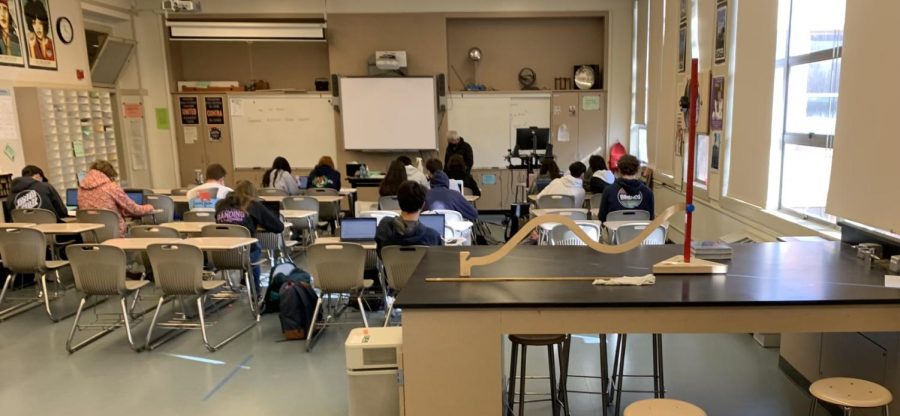Sub-Apocalypse
IB Physics class subbed by Mr. Ton-Tho
March 7, 2022
Substitute teachers have a reputation for providing students with an enjoyable level of chaos for a day while the teacher has to be out. With the best of intentions, they attempt to control a class they may have no previous experience with for 100 minutes at a time. But when those minutes turn into days or even weeks, when a teacher is unable to return to their class for extended periods of time, that enjoyable chaos turns sour.
The chaos of substitutes:
A substitute’s job, for the most part, consists of handing out assignments, giving instructions, and letting the students do work on their own. If the substitute has experience with the subject, either from teaching or learning it, they might even be able to assist the students with this work. Substitutes are not meant to last more than a day or two at most though, and students can lose real learning opportunities if the substitute starts to become their permanent teacher.
For example, half way through last semester, an IB English II teacher left Sequoia, and her class was taken over by a long term substitute. “Last semester was a pretty memorable negative experience,” said senior Domenica Bamford, a student in this class. “The substitute we had, she was lovely, and she was trying her best and she was really sweet. But she was not an English teacher, and it was obvious that she didn’t know what she was doing. And honestly, she was probably just as confused as we were. And that’s hard when you’re in a class with a bunch of students and your teacher’s basically like another student.”
Students are not the only ones who notice when the substitutes are lost or confused. The substitutes themselves know that having previous experience with the material is a benefit to all.
Substitute teacher Tristan Alvarado-Arana, known by students as Alex, said that “it’s nice to have [a substitute teacher] because that means there’s a staff member who can be in that classroom, but it’s so much better when [substitute teachers] understand the material and can engage with students […] and actually help them understand it.”
Despite lacking experience with a subject, some faculty members feel relatively confident that students will get the same material when a substitute teacher is in charge of them.
“I think one of the things we’re really fortunate to have is a super strong curriculum team. Even if a student has a substitute, they’re still getting the same assignments and the same material,” Instructional Vice Principal Kristin Stout said.
But students may not feel as if that is always the case.
After switching into a new IB English class this semester, Bamford said, “It’s easy to tell that we have not done a lot of the things that [other classes] did. And it’s not just that we did something different. It’s a ‘we skipped this. We skipped that. I knew the other classes were doing this but we didn’t do this.’” She added, “We didn’t have the instructions. I knew it existed, but I didn’t know we were supposed to be doing something.”
The struggle to find a substitute:
In the past decade in California, teacher preparation enrollment (or the number of people enrolled to obtain teaching credentials) has declined by more than 70 percent, according to the Learning Policy Institute. The same study also found that 80 percent of California school districts are thus affected by teacher shortages. This problem has only been accentuated by the pandemic, as the number of teachers retiring has increased while the number of teacher candidates has decreased. According to LPI, by 2025, 316,000 new teachers will be needed each year. This number has increased by 16,000 since 2020. And as teachers were leaving their jobs, many substitutes also quit to find a more stable, less risky job, according to Ed Source in an article from September 2021.
To deal with the decline in substitutes and teachers, Stout explained that Sequoia “put something new in place this semester that is like a jury pool. So every week, a group of teachers know that they may be called upon to substitute for one of their prep periods just for that week.”
For the students, this is a great fix because it means they will always have a teacher in their class, even if it is not their regular teacher. But for the teachers themselves, this can add more work to their already busy schedules.
IB English II and Theory of Knowledge teacher Justine Rutigliano has direct experience with the decline of teachers and substitutes, as she gained students this semester from the English class that lacked a teacher. “This semester, administration has asked us to commit to [subbing one class] a semester. So we’re in a sub pool. And so we have to be on call for a prep period. But it is just one time for this semester, so not terrible,” she said, adding, “It has definitely been an issue with people having to be out for ten days if they are exposed. And of course if they’re sick, sometimes it’s even longer than that. So that’s been very, very stressful.”
Though there has been an uptick in teachers subbing for other teachers’ classes, substitutes have not left entirely. Some, like Andrew Kahn, have been at Sequoia for multiple years now and still enjoy it.
“It’s been a pretty good experience being able to go into classrooms and meet students and just kind of see what life is like for students in the classroom because it’s been a little while for me,” Kahn said. He added that subbing for Ms. Perez, one of Sequoia’s counselors “has probably been [his] favorite experience serving so far because [he] wants to become a counselor.”
Students can have a similarly good experiences with substitute teachers too.
Sophomore Olivia Stathis said, “I like having subs because it’s like […] a fresh start, and usually they’re not too bad […] You never know, […] I guess it just really depends on what the sub is like.”
This year, good substitutes have been in higher demand than ever before, but as California faces such a drastic drop in eligible teachers, substitutes are difficult to find, which led to the loosening of some requirements to be a substitute. Instead of taking the California Basic Education Skills Test to demonstrate competency, they can use eligible coursework from college or standardized testing scores. Many schools, including Sequoia, are even increasing their daily pay to $240 for a substitute teacher to encourage new applicants.
At the beginning of this semester, the requirements to be a substitute were loosened even more. “If a district asks for a temporary suspension, all you need is a college degree. They’ve actually suspended anything related to the CBES, but a district has to ask the state for a waiver… They’re trying to respond to the increase in needs,” Stout said.
Some districts are even reaching out to parents to fill the gaps. The Sequoia Union High School District Human Resources department sent out an email to all parents and students of the District “looking for caring and passionate people to make a difference in the education of our students. [They] are recruiting to hire substitute teachers from members of our community who know our schools and students.”
It’s a well known issue that teachers, as well as substitutes, are underpaid and overworked. The cost of living in the United States, specifically the Bay Area, is getting exponentially higher while salaries in education are falling behind, which makes it hard for some teachers to be able to keep teaching. Stout explained that, “For a lot of people it’s very difficult to pay rent or to buy a house so I think that was mostly [the reason why teachers left]. I think that people who left would say, ‘it’s not the school, it’s not the profession. I love it. I just can’t afford to live here.’”
The resolution for substitutes:
The juxtaposition between the desperate need for substitute teachers and the chaos that can ensue from their staying in a class for too long is a difficult line to balance on. The problem increased as the pandemic grew, and does not seem to be slowing down. There is no clear answer to the problem, and many questions have been raised.
“I think the pandemic just took the wind out of peoples’ sails,” Rutigliano said. “I wonder what the deal is with the substitutes. You know, should we pay them more? Could we pay them more? Could we offer them some sort of incentives? Is it just an absolutely miserable job that people don’t want to do? We are in a profession that relies heavily on humans, so we need substitute teachers for sure, so I don’t know what the answer to that is.”






